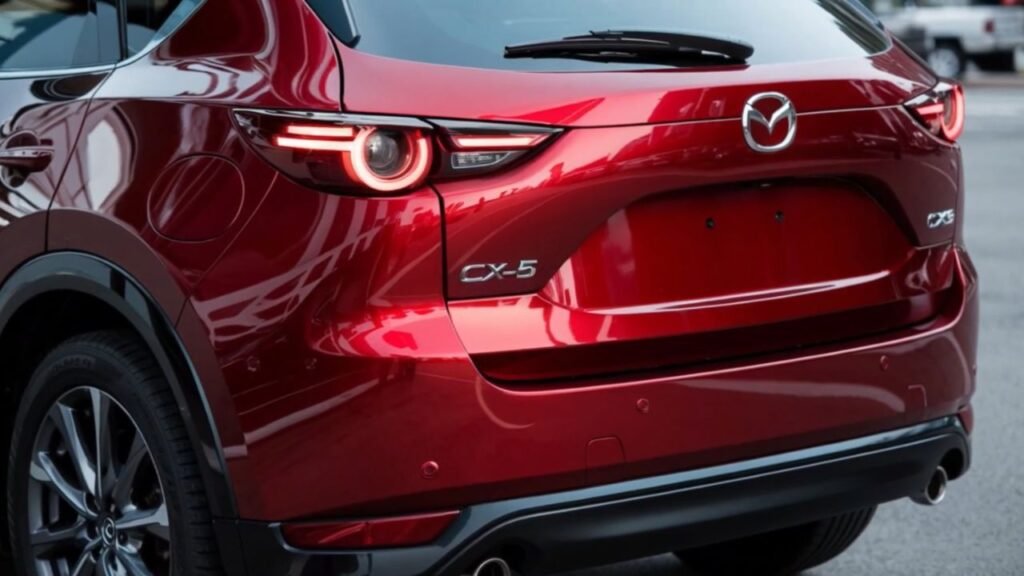Mazda’s CX-5 has long been a staple in the compact SUV segment, offering a blend of style, driving dynamics, and value. For 2026, Mazda plans to usher in significant updates to the CX-5, signaling a new era for the brand with improved powertrains, enhanced technology, and refined design. Here’s a detailed look at what we can expect from the upcoming model, based on recent announcements and insights.
2026 Mazda CX-5 Specs:

| Feature | Specification |
|---|---|
| Engines | 2.5L Inline-4 (187 hp, 186 lb-ft) |
| 2.5L Turbo Inline-4 (256 hp, 320 lb-ft) | |
| Transmission | 6-speed automatic with standard all-wheel drive |
| Fuel Economy | 24/30 mpg (city/highway) for base engine; 22/27 mpg for turbo variant |
| Dimensions (L x W x H) | 189.4 x 72.6 x 66.9 inches |
| Cargo Space | 29.1 cu ft (rear seats up); 58.1 cu ft (rear seats folded) |
| Interior Features | Panoramic sunroof, ambient lighting, wireless charging, head-up display |
| Infotainment | Large touchscreen with Apple CarPlay/Android Auto, optional rotary control knob |
| Safety Features | Lane departure warning, adaptive cruise control, blind-spot monitoring |
| Trims & Pricing | Base ($27,000), Select ($29,000), Premium Plus ($36,000), Turbo Signature ($42,000) |
| Exterior Features | Bold grille, slim LED headlights, dual exhaust, 17-19 inch alloy wheels |
A New Heart: SkyActiv Z Engine
Mazda is set to phase out its current SkyActiv-G and SkyActiv-X engine technologies, introducing the all-new SkyActiv-Z engine in the 2026 CX-5. This engine promises improved thermal efficiency and environmental friendliness. Featuring advanced “Lambda 1 combustion” technology, it aims to deliver a super-lean burn for better fuel economy and reduced emissions. While specific power figures are yet to be confirmed, the engine will likely offer a balance of performance and efficiency, aligning with Mazda’s reputation for sporty yet practical vehicles.
The CX-5 may also include Mazda’s proprietary hybrid system, leveraging technology developed with Toyota. This hybrid option is expected to debut in mid- to small-sized vehicles like the CX-5, alongside traditional gas-powered versions.
2026 Mazda CX-5 0-60 mph and 0-100 km/h

- The 2023 Mazda CX-5 Turbo trims clocked 0-60 mph times between 6.1 to 6.5 seconds, depending on the configuration. For naturally aspirated versions, times were closer to 7.9 seconds.
- Given this, the 2026 model with the likely retention of the turbocharged 2.5L engine and potential mild-hybrid enhancements may achieve a 0-60 mph time of around 6.0 seconds for turbo trims and closer to 7.5 seconds for non-turbo variants.
- The equivalent 0-100 km/h times are estimated at approximately 6.3 seconds (turbo) and 7.8 seconds (non-turbo).
2026 Mazda CX-5 Top Speed

- Previous CX-5 models have a top speed of around 124 to 130 mph (200-209 km/h). The 2026 model, maintaining a similar powertrain and focusing on efficiency, is expected to retain a top speed of approximately 130 mph for turbo variants and slightly lower for non-turbo configurations.
Design Evolution: A Nod to Premium
The 2026 CX-5 is expected to adopt a design inspired by Mazda’s concept cars, such as the Arata Concept. The anticipated design features a more aggressive front grille, sharp C-pillars, and sleek LED lighting, giving it a modern and premium look. Mazda aims to maintain the CX-5’s sporty stance while enhancing its aerodynamics and curb appeal. The rear design may include unique lighting configurations and possibly a hidden or repositioned rear windshield wiper.
2026 Mazda CX-5 Exterior Dimensions

Details about the exterior dimensions of the 2026 Mazda CX-5 are not yet fully disclosed, as Mazda has not officially released this data. However, the vehicle is expected to slightly grow in size compared to the current model, aligning with its updated, modernized design. The changes include a larger grille, slimmer headlights, and a more streamlined appearance, potentially making it longer, wider, and more imposing.
Cargo Space
The 2026 Mazda CX-5 offers:
- 29.1 cubic feet of cargo space behind the rear seats.
- This expands to 58.1 cubic feet when the rear seats are folded, providing significant versatility for carrying larger items.
Simplified Trim Levels
To streamline the buying process, Mazda is reducing the number of available trims for the CX-5. Instead of the current extensive range, buyers will choose from three core configurations: base, mid-grade, and premium. This simplification is part of Mazda’s strategy to enhance efficiency and profitability, particularly in markets like North America where demand for the CX-5 remains strong.
Electrification and Future Technologies
While the initial 2026 CX-5 models are likely to feature the SkyActiv-Z engine and hybrid options, Mazda plans to integrate more advanced electrification technologies over time.
This includes potential plug-in hybrid (PHEV) variants and scalable battery-electric vehicle (BEV) platforms in future iterations. These advancements align with Mazda’s goal of reducing its environmental footprint and meeting evolving global regulations.
Expected Fuel Efficiency
2026 Mazda CX-5 is expected to feature improved fuel efficiency, particularly with the addition of a hybrid powertrain based on the 2.5L Skyactiv-G engine.
The hybrid model is projected to exceed 40 MPG combined, aligning with competitors like the Toyota RAV4 Hybrid. For standard ICE versions, the fuel economy is estimated to remain similar to current models, at around 25 MPG city and 32 MPG highway.
Interior and Features
The new CX-5 will likely retain its reputation for offering a driver-focused interior, featuring high-quality materials and an intuitive layout. Expect an upgraded infotainment system, advanced driver-assistance features, and improved connectivity options. Mazda also aims to optimize production costs without sacrificing the vehicle’s premium feel, ensuring competitive pricing despite the updates.
Market Outlook and Challenges
The CX-5 is critical to Mazda’s global sales strategy, particularly in the U.S., where it accounts for a significant portion of the brand’s volume. However, challenges like declining sales in Japan and Europe, as well as financial pressures from high incentives, may impact the launch timeline or pricing. Nevertheless, the CX-5’s strong reputation and loyal customer base are expected to support its continued success.
2026 Mazda CX-5 Competitors Analysis

2026 Mazda CX-5 will face strong competition in the compact SUV market, primarily from models that emphasize performance, technology, and value. Key expected competitors include:
1. Toyota RAV4
- Engines: Standard 2.5L I4 (203 hp); Hybrid (219 hp); Plug-in Hybrid (RAV4 Prime: 302 hp).
- Features: Toyota Safety Sense 3.0, available all-wheel drive, up to 42 miles of EV range for the plug-in hybrid.
- Price Range (Estimate): Starting around $28,000.
2. Honda CR-V
- Engines: 1.5L Turbo I4 (190 hp) or 2.0L hybrid powertrain (204 hp combined).
- Interior: Spacious design with Honda Sensing safety features and a modern infotainment system.
- Fuel Economy: Up to 40 mpg combined (hybrid).
- Price Range (Estimate): $28,000–$40,000.
3. Hyundai Tucson
- Engines: 2.5L I4 (187 hp), hybrid (227 hp), plug-in hybrid (261 hp).
- Tech: Dual 10.25-inch displays, comprehensive driver assistance systems.
- Interior: Bold design with advanced tech and sustainable materials.
- Price Range (Estimate): Starting around $27,000.
4. Kia Sportage
- Engines: Similar to the Tucson, offering internal combustion, hybrid, and plug-in hybrid options.
- Features: Panoramic displays, upscale trims, and excellent warranty.
- Price Range (Estimate): $27,500–$38,000.
5. Ford Escape
- Engines: 1.5L EcoBoost (181 hp), 2.0L EcoBoost (250 hp), and hybrid options.
- Technology: Sync 4 system, Co-Pilot360 safety suite.
- Price Range (Estimate): $28,000–$42,000.
6. Subaru Forester
- Engine: 2.5L Boxer engine (182 hp) with standard all-wheel drive.
- Features: Off-road-focused Wilderness trim, EyeSight safety tech.
- Price Range (Estimate): $27,500–$37,000.
The 2026 Mazda CX-5, with its combination of refined styling, engaging driving dynamics, and luxurious interiors, is well-positioned against these rivals. Expected specifications include two powertrains: a standard 2.5L I4 (187 hp) and an optional 2.5L turbocharged engine (256 hp). Fuel economy is estimated at 24–30 mpg depending on the engine. Its upscale design, advanced safety features, and trims like the all-new Carbon Turbo make it a compelling choice, starting around $27,000 and reaching $42,000 at the high end.
Release Timeline
The redesigned CX-5 is expected to arrive by late 2025 or early 2026, depending on market conditions and production schedules. The hybrid variant may follow shortly after its launch.
Conclusion
The 2026 Mazda CX-5 is shaping up to be a transformative model for the brand, combining advanced engine technologies, electrification, and a fresh design language. While Mazda faces financial and market challenges, the CX-5’s updates position it to remain a strong contender in the fiercely competitive compact SUV segment. With its balance of style, performance, and innovation, the 2026 CX-5 could redefine expectations for its class.


